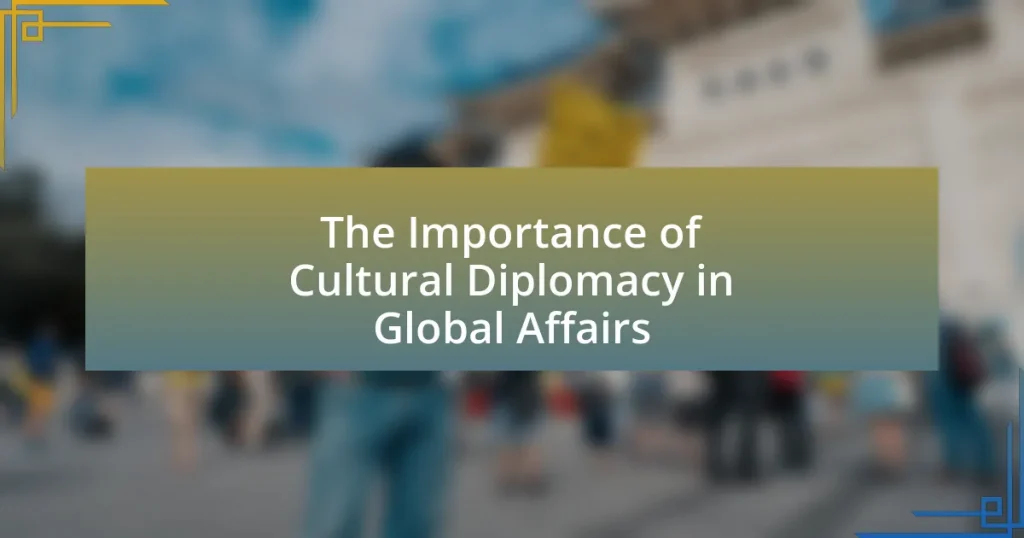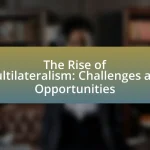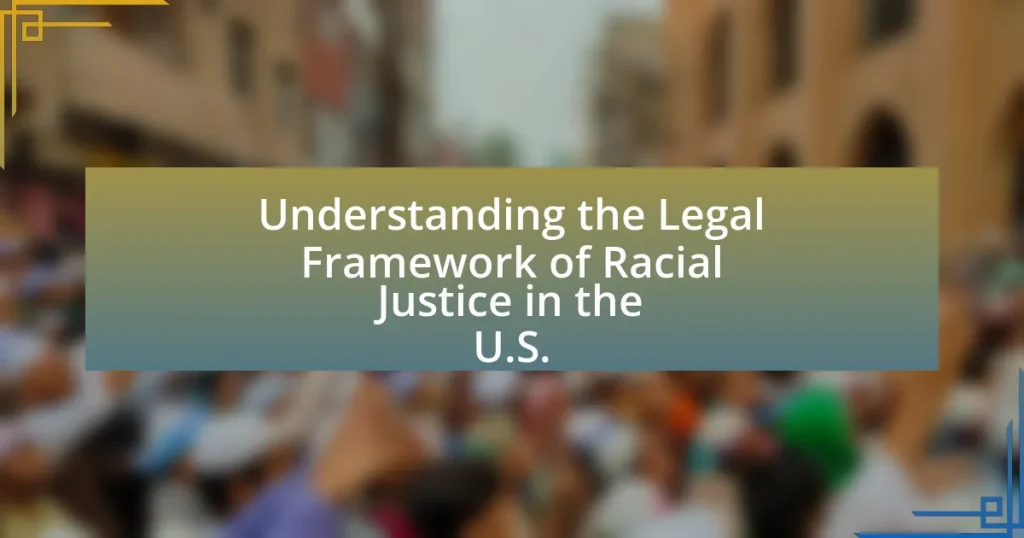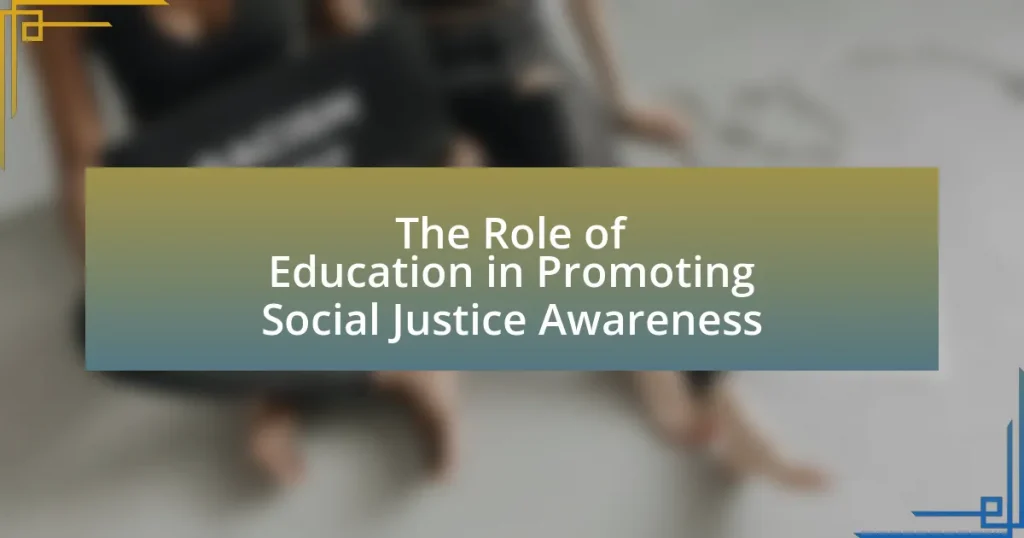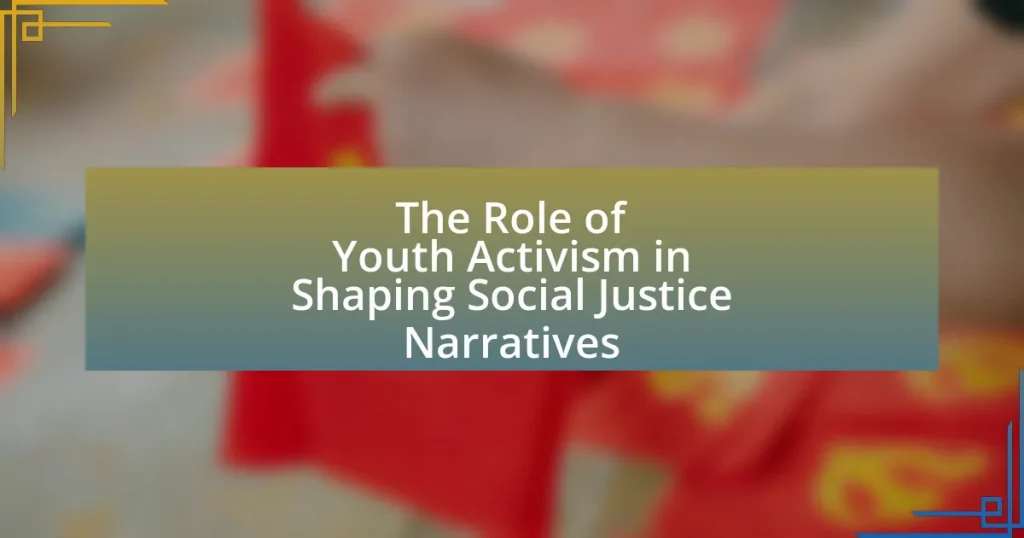Cultural diplomacy in global affairs is defined as the use of cultural exchanges and initiatives to enhance mutual understanding and strengthen international relationships. This article explores the influence of cultural diplomacy on international relations, highlighting its key components such as cultural exchange, mutual understanding, and soft power. It examines how cultural diplomacy differs from traditional diplomacy, its importance in today’s world, and its role in conflict resolution. Additionally, the article discusses the methods and strategies countries employ to implement cultural diplomacy, the challenges faced, and the impacts on global issues like climate change and human rights. Through various examples, the article underscores the significance of cultural diplomacy in fostering cooperation and addressing contemporary global challenges.

What is Cultural Diplomacy in Global Affairs?
Cultural diplomacy in global affairs refers to the use of cultural exchanges and initiatives to foster mutual understanding and strengthen relationships between nations. This practice involves promoting a country’s culture, values, and ideas through various means such as art, education, and public diplomacy, thereby enhancing international cooperation. For instance, programs like the Fulbright Program and cultural festivals serve as platforms for dialogue and collaboration, demonstrating the effectiveness of cultural diplomacy in addressing global challenges and building soft power.
How does Cultural Diplomacy influence international relations?
Cultural diplomacy influences international relations by fostering mutual understanding and cooperation between nations through cultural exchanges and dialogue. This approach enhances soft power, allowing countries to project their values and culture, which can lead to improved diplomatic relations and conflict resolution. For instance, the United States has utilized cultural diplomacy through programs like the Fulbright Scholarship, which has facilitated educational exchanges and strengthened ties with over 160 countries since its inception in 1946. Such initiatives demonstrate how cultural diplomacy can create lasting connections and promote peace, thereby significantly impacting global affairs.
What are the key components of Cultural Diplomacy?
The key components of Cultural Diplomacy include cultural exchange, mutual understanding, and soft power. Cultural exchange involves the sharing of art, music, literature, and traditions between nations, fostering connections and appreciation. Mutual understanding emphasizes the importance of dialogue and collaboration to bridge cultural differences, enhancing international relations. Soft power refers to the ability of a country to influence others through cultural appeal rather than coercion, as demonstrated by the global impact of American films and music or the promotion of French culture through language and cuisine. These components collectively contribute to building relationships and promoting peace in global affairs.
How does Cultural Diplomacy differ from traditional diplomacy?
Cultural diplomacy differs from traditional diplomacy primarily in its focus on cultural exchange rather than political negotiation. While traditional diplomacy often involves formal discussions between government representatives to address political, economic, or military issues, cultural diplomacy emphasizes the promotion of mutual understanding and respect through cultural interactions, such as art, education, and language. For instance, initiatives like the Fulbright Program, which facilitates educational exchanges, exemplify how cultural diplomacy fosters relationships that can lead to more effective political dialogue. This distinction highlights that cultural diplomacy aims to build long-term relationships and soft power, whereas traditional diplomacy typically seeks immediate political outcomes.
Why is Cultural Diplomacy important in today’s world?
Cultural diplomacy is important in today’s world because it fosters mutual understanding and cooperation among nations. By promoting cultural exchange, countries can build relationships that transcend political and economic differences, enhancing global stability. For instance, initiatives like the UNESCO World Heritage program highlight the significance of cultural heritage, encouraging nations to collaborate on preserving shared history. This collaboration can lead to conflict resolution and peacebuilding, as seen in various international cultural festivals that bring together diverse communities to celebrate their differences and commonalities.
What role does Cultural Diplomacy play in conflict resolution?
Cultural diplomacy plays a crucial role in conflict resolution by fostering mutual understanding and dialogue between conflicting parties. It utilizes cultural exchanges, art, and education to bridge divides, allowing individuals to appreciate diverse perspectives and values. For instance, programs like the U.S. State Department’s Cultural Diplomacy initiatives have successfully engaged communities in conflict zones, promoting peace through shared cultural experiences. Research indicates that such initiatives can reduce tensions and build trust, as seen in the case of post-apartheid South Africa, where cultural diplomacy helped reconcile differences and promote national unity.
How does Cultural Diplomacy promote mutual understanding among nations?
Cultural diplomacy promotes mutual understanding among nations by facilitating the exchange of cultural values, ideas, and practices. This exchange fosters empathy and respect, allowing nations to appreciate each other’s heritage and perspectives. For instance, programs like international art exhibitions and cultural festivals enable direct interaction between diverse populations, breaking down stereotypes and building relationships. Research by the British Council indicates that cultural engagement can lead to improved international relations, as it enhances trust and cooperation among countries.
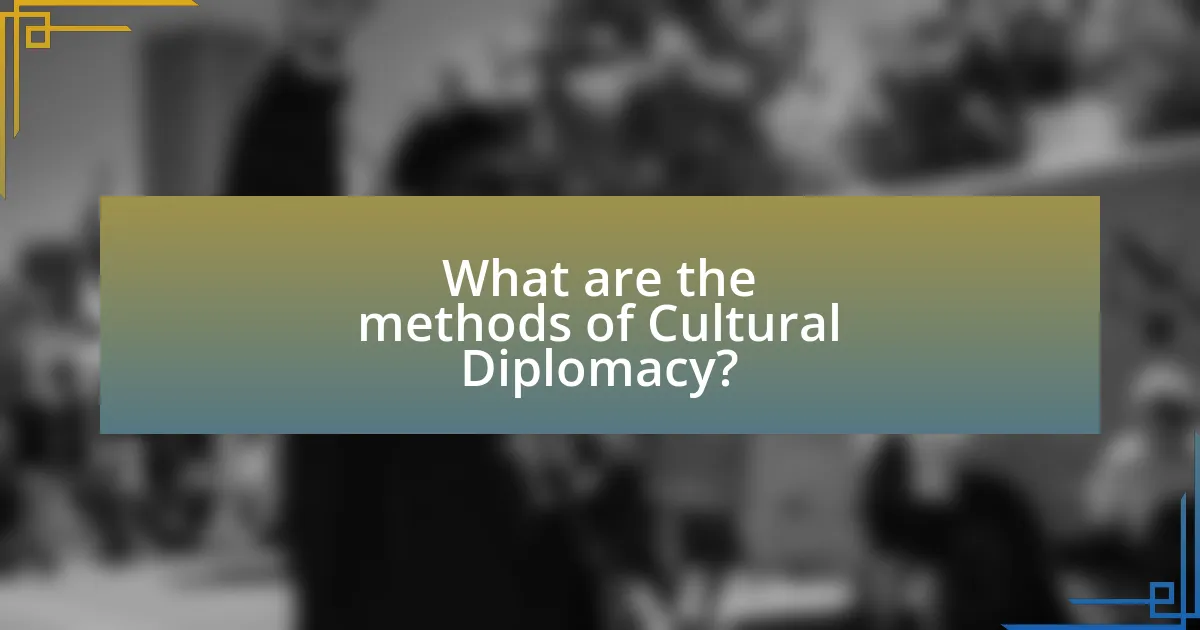
What are the methods of Cultural Diplomacy?
Cultural diplomacy employs various methods to foster international relations and mutual understanding. These methods include cultural exchanges, where artists, scholars, and professionals share their work and ideas across borders; educational programs that promote study abroad opportunities and academic collaborations; and the establishment of cultural institutions, such as cultural centers and language schools, that facilitate ongoing engagement. Additionally, public diplomacy initiatives, including film festivals, art exhibitions, and music performances, serve to showcase a nation’s culture and values, thereby enhancing its soft power. These methods are effective as they create platforms for dialogue and collaboration, ultimately contributing to peaceful coexistence and cooperation among nations.
How do countries implement Cultural Diplomacy strategies?
Countries implement Cultural Diplomacy strategies through various methods, including cultural exchanges, international collaborations, and the promotion of national art and heritage. For instance, nations often establish cultural institutes abroad, such as the British Council or the Goethe-Institut, which facilitate language learning and cultural programs, thereby enhancing mutual understanding. Additionally, countries participate in international festivals and exhibitions, showcasing their cultural products and fostering dialogue. Research indicates that these strategies can improve bilateral relations and enhance a country’s soft power, as evidenced by the rise in tourism and international partnerships following successful cultural initiatives.
What types of cultural exchanges are most effective?
The most effective types of cultural exchanges are those that foster direct interpersonal interactions, such as student exchange programs, artist residencies, and cultural festivals. These exchanges promote mutual understanding and collaboration by allowing participants to immerse themselves in different cultures, thereby enhancing empathy and reducing stereotypes. For instance, the Fulbright Program, which facilitates international educational exchanges, has shown to significantly improve cross-cultural communication skills among participants, as evidenced by surveys indicating that 90% of alumni reported a greater appreciation for cultural diversity.
How do art and education contribute to Cultural Diplomacy?
Art and education significantly contribute to cultural diplomacy by fostering mutual understanding and respect among nations. Art serves as a universal language that transcends cultural barriers, allowing for the expression of shared values and experiences. For instance, international art exhibitions, such as the Venice Biennale, promote cross-cultural dialogue and collaboration, showcasing diverse artistic perspectives that enhance global cultural exchange.
Education, on the other hand, plays a crucial role in cultural diplomacy by promoting knowledge and awareness of different cultures. Programs like Fulbright scholarships facilitate academic exchanges, enabling students and scholars to immerse themselves in foreign cultures, thereby building lasting relationships and networks. According to the U.S. Department of State, educational exchanges have been shown to improve international relations by creating a foundation of trust and collaboration among future leaders.
Together, art and education not only enrich cultural understanding but also serve as strategic tools for nations to engage with one another, ultimately contributing to a more peaceful and cooperative global community.
What challenges does Cultural Diplomacy face?
Cultural diplomacy faces several significant challenges, including political tensions, cultural misunderstandings, and resource limitations. Political tensions can hinder collaborative efforts, as nations may prioritize their interests over cultural exchange. Cultural misunderstandings arise when differing values and norms lead to misinterpretations, potentially damaging relationships. Additionally, resource limitations, such as funding and personnel, restrict the ability to implement effective cultural programs. These challenges are evident in various instances, such as the impact of geopolitical conflicts on international cultural initiatives, which often stall or become contentious.
How do political tensions affect Cultural Diplomacy efforts?
Political tensions significantly hinder Cultural Diplomacy efforts by creating an environment of mistrust and hostility between nations. When countries experience strained relations, cultural exchanges, collaborations, and initiatives often face restrictions or cancellations, limiting opportunities for mutual understanding and cooperation. For instance, during the Cold War, cultural diplomacy initiatives like the U.S. State Department’s cultural programs were often overshadowed by political conflicts, leading to reduced engagement and collaboration in the arts and education sectors. This historical context illustrates how political discord can directly impede the effectiveness of cultural diplomacy, as nations prioritize political agendas over cultural interactions.
What are the limitations of Cultural Diplomacy in global affairs?
Cultural diplomacy has several limitations in global affairs, primarily its inability to address political and economic conflicts effectively. While cultural exchanges can foster mutual understanding, they often fall short in influencing policy decisions or resolving deep-seated geopolitical tensions. For instance, cultural diplomacy initiatives may be overshadowed by military or economic strategies, as seen in the U.S.-China relations where cultural programs have not mitigated trade disputes or security concerns. Additionally, cultural diplomacy can be perceived as one-sided or propagandistic, leading to skepticism among target audiences, which diminishes its effectiveness. Furthermore, the impact of cultural diplomacy is often difficult to measure, making it challenging to assess its success or justify investments in such initiatives.
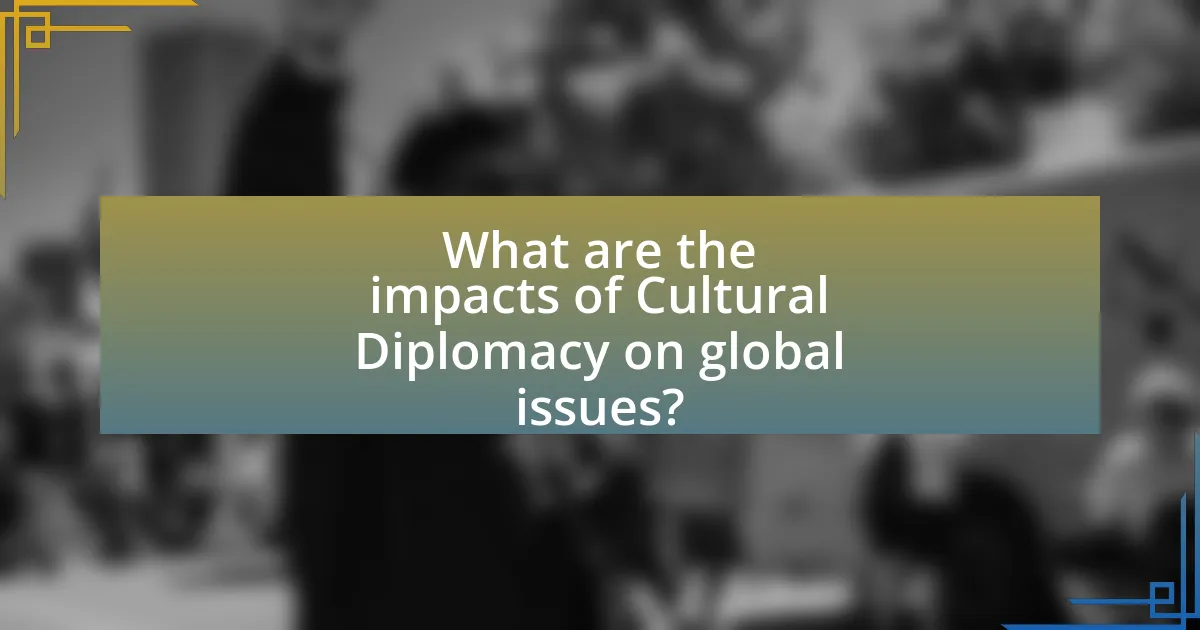
What are the impacts of Cultural Diplomacy on global issues?
Cultural diplomacy significantly impacts global issues by fostering mutual understanding and cooperation among nations. It enhances international relations by promoting cultural exchange, which can lead to improved political dialogue and conflict resolution. For instance, initiatives like the United Nations Educational, Scientific and Cultural Organization (UNESCO) promote cultural heritage preservation, which helps mitigate tensions in regions with diverse cultural backgrounds. Furthermore, cultural diplomacy can influence public opinion and soft power, as seen in the global reach of American cultural products, which often shape perceptions and attitudes towards the United States. This interplay between culture and diplomacy underscores the importance of cultural initiatives in addressing global challenges such as climate change, migration, and social cohesion.
How does Cultural Diplomacy address global challenges like climate change?
Cultural diplomacy addresses global challenges like climate change by fostering international cooperation and understanding through cultural exchanges and dialogue. This approach enables countries to share knowledge, best practices, and innovative solutions related to environmental sustainability. For instance, initiatives such as the UNESCO World Heritage program promote the preservation of cultural sites while emphasizing the importance of environmental stewardship, thereby linking cultural identity with climate action. Additionally, cultural diplomacy can mobilize public support for climate initiatives by engaging communities through art, education, and storytelling, which enhances awareness and drives collective action.
What role does Cultural Diplomacy play in promoting human rights?
Cultural diplomacy plays a crucial role in promoting human rights by fostering mutual understanding and respect among nations through cultural exchange and dialogue. This approach enables countries to share their values, traditions, and perspectives, which can lead to increased awareness and advocacy for human rights issues. For instance, initiatives like the United Nations Educational, Scientific and Cultural Organization (UNESCO) promote cultural heritage and diversity, which are essential for human rights advocacy. By highlighting the importance of cultural narratives, cultural diplomacy can challenge oppressive regimes and support marginalized voices, thereby reinforcing the global commitment to human rights.
How can Cultural Diplomacy foster economic partnerships?
Cultural diplomacy can foster economic partnerships by enhancing mutual understanding and trust between nations, which facilitates trade and investment opportunities. When countries engage in cultural exchanges, such as art exhibitions, educational programs, and collaborative projects, they build relationships that can lead to economic collaborations. For instance, the United States and Japan have historically used cultural diplomacy to strengthen their economic ties, resulting in significant trade agreements and investments, as evidenced by the U.S.-Japan Economic Partnership Agreement. This demonstrates that cultural diplomacy not only promotes goodwill but also creates a conducive environment for economic cooperation.
What best practices can enhance Cultural Diplomacy initiatives?
Best practices that can enhance Cultural Diplomacy initiatives include fostering genuine partnerships, promoting cultural exchange programs, and utilizing digital platforms for outreach. Genuine partnerships between countries and cultural institutions create trust and facilitate collaboration, as evidenced by successful initiatives like the U.S. State Department’s Arts Envoy program, which has effectively engaged international audiences. Cultural exchange programs, such as student exchange initiatives, enhance mutual understanding and appreciation, supported by research from the British Council indicating that such programs significantly improve intercultural relations. Additionally, leveraging digital platforms allows for broader engagement and accessibility, as seen during the COVID-19 pandemic when virtual cultural events reached global audiences, demonstrating the effectiveness of online diplomacy.
How can countries measure the success of their Cultural Diplomacy efforts?
Countries can measure the success of their Cultural Diplomacy efforts through various quantitative and qualitative metrics. These metrics include tracking the number of cultural exchange programs, assessing public opinion surveys regarding perceptions of the country’s culture, and analyzing the impact of cultural events on bilateral relations. For instance, the British Council reported that countries with active cultural diplomacy initiatives, such as the UK, saw a 20% increase in positive perceptions among foreign audiences following major cultural events. Additionally, monitoring social media engagement and attendance at cultural events provides concrete data on the reach and influence of cultural diplomacy initiatives.
What strategies can improve engagement through Cultural Diplomacy?
To improve engagement through Cultural Diplomacy, strategies such as fostering people-to-people connections, utilizing cultural exchanges, and promoting collaborative projects are essential. Fostering people-to-people connections enhances mutual understanding and trust, as evidenced by the success of programs like the Fulbright Program, which has facilitated academic exchanges between the U.S. and over 160 countries since 1946. Utilizing cultural exchanges, such as art exhibitions and performances, allows nations to showcase their heritage and values, creating a platform for dialogue and collaboration. Additionally, promoting collaborative projects, like joint cultural festivals or educational initiatives, encourages active participation and shared experiences, which have been shown to strengthen bilateral relations and cultural ties. These strategies collectively enhance engagement by creating a more interconnected global community.










